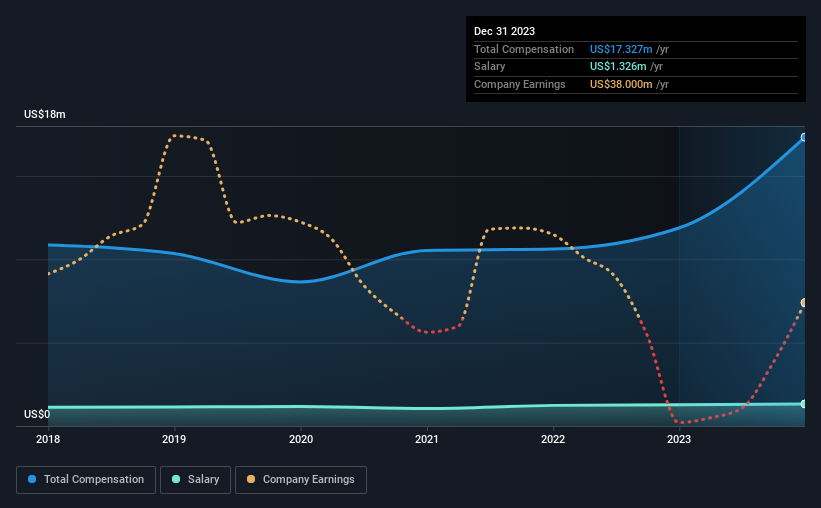Key Insights
-
Dana will host its Annual General Meeting on 24th of April
-
Total pay for CEO Jim Kamsickas includes US$1.33m salary
-
Total compensation is 142% above industry average
-
Over the past three years, Dana’s EPS fell by 66% and over the past three years, the total loss to shareholders 52%
Dana Incorporated (NYSE:DAN) has not performed well recently and CEO Jim Kamsickas will probably need to up their game. Shareholders will be interested in what the board will have to say about turning performance around at the next AGM on 24th of April. They will also get a chance to influence managerial decision-making through voting on resolutions such as executive remuneration, which may impact firm value in the future. From our analysis, we think CEO compensation may need a review in light of the recent performance.
View our latest analysis for Dana
How Does Total Compensation For Jim Kamsickas Compare With Other Companies In The Industry?
According to our data, Dana Incorporated has a market capitalization of US$1.7b, and paid its CEO total annual compensation worth US$17m over the year to December 2023. We note that’s an increase of 46% above last year. While we always look at total compensation first, our analysis shows that the salary component is less, at US$1.3m.
In comparison with other companies in the American Auto Components industry with market capitalizations ranging from US$1.0b to US$3.2b, the reported median CEO total compensation was US$7.2m. This suggests that Jim Kamsickas is paid more than the median for the industry. Moreover, Jim Kamsickas also holds US$8.6m worth of Dana stock directly under their own name, which reveals to us that they have a significant personal stake in the company.
|
Component |
2023 |
2022 |
Proportion (2023) |
|
Salary |
US$1.3m |
US$1.3m |
8% |
|
Other |
US$16m |
US$11m |
92% |
|
Total Compensation |
US$17m |
US$12m |
100% |
Speaking on an industry level, nearly 14% of total compensation represents salary, while the remainder of 86% is other remuneration. In Dana’s case, non-salary compensation represents a greater slice of total remuneration, in comparison to the broader industry. If total compensation is slanted towards non-salary benefits, it indicates that CEO pay is linked to company performance.
A Look at Dana Incorporated’s Growth Numbers
Over the last three years, Dana Incorporated has shrunk its earnings per share by 66% per year. It achieved revenue growth of 3.9% over the last year.
The decline in EPS is a bit concerning. The modest increase in revenue in the last year isn’t enough to make us overlook the disappointing change in EPS. It’s hard to argue the company is firing on all cylinders, so shareholders might be averse to high CEO remuneration. Historical performance can sometimes be a good indicator on what’s coming up next but if you want to peer into the company’s future you might be interested in this free visualization of analyst forecasts.
Has Dana Incorporated Been A Good Investment?
The return of -52% over three years would not have pleased Dana Incorporated shareholders. Therefore, it might be upsetting for shareholders if the CEO were paid generously.
In Summary…
Given that shareholders haven’t seen any positive returns on their investment, not to mention the lack of earnings growth, this may suggest that few of them would be willing to award the CEO with a pay rise. At the upcoming AGM, management will get a chance to explain how they plan to get the business back on track and address the concerns from investors.
While CEO pay is an important factor to be aware of, there are other areas that investors should be mindful of as well. We did our research and spotted 2 warning signs for Dana that investors should look into moving forward.
Of course, you might find a fantastic investment by looking at a different set of stocks. So take a peek at this free list of interesting companies.
Have feedback on this article? Concerned about the content? Get in touch with us directly. Alternatively, email editorial-team (at) simplywallst.com.
This article by Simply Wall St is general in nature. We provide commentary based on historical data and analyst forecasts only using an unbiased methodology and our articles are not intended to be financial advice. It does not constitute a recommendation to buy or sell any stock, and does not take account of your objectives, or your financial situation. We aim to bring you long-term focused analysis driven by fundamental data. Note that our analysis may not factor in the latest price-sensitive company announcements or qualitative material. Simply Wall St has no position in any stocks mentioned.
